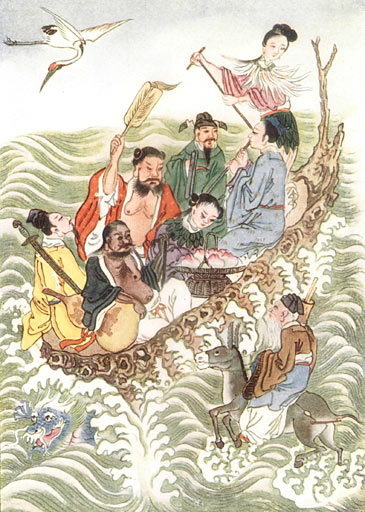|
仙
A ''xian'' ( zh, s=仙, t=僊, p=xiān, w=hsien) is any manner of immortal or mythical being within the Taoist pantheon or Chinese folklore. has often been translated into English as "immortal" or "wizard". Traditionally, ''xian'' refers to entities who have attained immortality and supernatural or magical abilities later in life, with a connection to the heavenly realms inaccessible to mortals. This is often achieved through spiritual self-cultivation, alchemy, or worship by others. This is different from the gods (deities) in Chinese mythology and Taoism. ''Xian'' is also used as a descriptor to refer to often benevolent figures of great historical, spiritual and cultural significance. The Quanzhen School of Daoism had a variety of definitions for during its history, including a metaphorical meaning where the term simply means a good, principled person. ''Xian'' have been venerated from ancient times to the modern day in a variety of ways across different cultures and ... [...More Info...] [...Related Items...] OR: [Wikipedia] [Google] [Baidu] |
Eight Immortals
The Eight Immortals () are a group of legendary ''Xian (Taoism), xian (immortals)'' in Chinese mythology. Each immortal's power can be transferred to a vessel () that can bestow life or destroy evil. Together, these eight vessels are called the "Covert Eight Immortals" (). Most of them are said to have been born in the Tang dynasty, Tang or Song dynasty, Song Dynasty. They are revered by the Taoism, Taoists and are also a popular element in secular Chinese culture. They are said to live on a group of five islands in the Bohai Sea, which includes Mount Penglai. The Immortals are: * He Xiangu (), in modern context generally seen as the only female of the group, often depicted holding a lotus flower. * Cao Guojiu (), related to a Song dynasty emperor before he became an immortal. * Li Tieguai (), considered to be mentally disturbed and associated with medicine and easing the suffering of the sick and needy, identified by his iron crutch and calabash bottle. * Lan Caihe (), originall ... [...More Info...] [...Related Items...] OR: [Wikipedia] [Google] [Baidu] |
Taoism
Taoism or Daoism (, ) is a diverse philosophical and religious tradition indigenous to China, emphasizing harmony with the Tao ( zh, p=d√Ýo, w=tao4). With a range of meaning in Chinese philosophy, translations of Tao include 'way', 'road', 'path', or 'technique', generally understood in the Taoist sense as an enigmatic process of transformation Ultimate reality, ultimately underlying reality. Taoist thought has informed the development of various practices within the Taoist tradition and beyond, including forms of Taoist meditation, meditation, Chinese astrology, astrology, qigong, feng shui, and Neidan, internal alchemy. A common goal of Taoist practice is self-cultivation, a deeper appreciation of the Tao, and more harmonious existence. Taoist ethics vary, but generally emphasize such virtues as ''wu wei, effortless action'', ziran, ''naturalness'', ''pu (Taoism), simplicity'', and the Three Treasures (Taoism), three treasures of compassion, frugality, and humility. The co ... [...More Info...] [...Related Items...] OR: [Wikipedia] [Google] [Baidu] |
Taoist
Taoism or Daoism (, ) is a diverse philosophical and religious tradition indigenous to China, emphasizing harmony with the Tao ( zh, p=d√Ýo, w=tao4). With a range of meaning in Chinese philosophy, translations of Tao include 'way', 'road', 'path', or 'technique', generally understood in the Taoist sense as an enigmatic process of transformation ultimately underlying reality. Taoist thought has informed the development of various practices within the Taoist tradition and beyond, including forms of meditation, astrology, qigong, feng shui, and internal alchemy. A common goal of Taoist practice is self-cultivation, a deeper appreciation of the Tao, and more harmonious existence. Taoist ethics vary, but generally emphasize such virtues as '' effortless action'', ''naturalness'', ''simplicity'', and the three treasures of compassion, frugality, and humility. The core of Taoist thought crystallized during the early Warring States period (), during which the epigrammatic an ... [...More Info...] [...Related Items...] OR: [Wikipedia] [Google] [Baidu] |
Fox Spirit
Huli jing () are Chinese mythological creatures usually capable of shapeshifting, who may either be benevolent or malevolent spirits. In Chinese mythology and folklore, the fox spirit takes variant forms with different meanings, powers, characteristics, and shapes, including , , , , , , and . Fox spirits and nine-tailed foxes appear frequently in Chinese folklore, literature, and mythology. Depending on the story, the fox spirit's presence may be a good or a bad omen. The motif of nine-tailed foxes from Chinese culture was eventually transmitted and introduced to Japanese, Korean, and Vietnamese cultures. Descriptions The nine-tailed fox occurs in the ''Shanhaijing'' (''Classic of Mountains and Seas''), compiled from the Warring States period to the Western Han period (circa fourth to circa first century BC). The work states: In chapter 14 of the ''Shanhaijing'', Guo Pu, a scholar of the Eastern Jin dynasty, had commented that the "nine-tailed fox was an auspicious omen ... [...More Info...] [...Related Items...] OR: [Wikipedia] [Google] [Baidu] |


